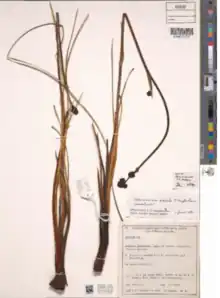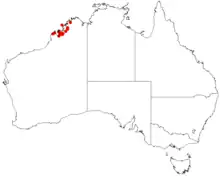Haemodorum gracile
Haemodorum gracile is a plant in the Haemodoraceae (blood root) family, native to Western Australia,[2] and was first described by Terry Desmond Macfarlane in 1987.[3][4]
| Haemodorum gracile | |
|---|---|
 | |
| NSW811719[1] | |
| Scientific classification | |
| Kingdom: | Plantae |
| Clade: | Tracheophytes |
| Clade: | Angiosperms |
| Clade: | Monocots |
| Clade: | Commelinids |
| Order: | Commelinales |
| Family: | Haemodoraceae |
| Genus: | Haemodorum |
| Species: | H. gracile |
| Binomial name | |
| Haemodorum gracile | |
 | |
It is a bulbous perennial herb, growing from 0.4-0.65 m high, on sands and sandy clays in the west Kimberley region of Western Australia.[5] Its red/brown flowers are seen from August to November.[3]
References
- "GBIF: Haemodorum gracile - Occurrence Detail 2828038624". www.gbif.org. Retrieved 23 January 2023.
- "Haemodorum gracile T.D.Macfarl. | Plants of the World Online | Kew Science". Plants of the World Online. Retrieved 24 January 2023.
- Grazyna Paczkowska (22 June 1994). "Haemodorum gracile T.Macfarlane". FloraBase - The Western Australian Flora. Western Australian Herbarium. Retrieved 23 January 2023.
- Macfarlane, T.D. (1987). George, A.S. (ed.). "Appendix: Haemodorum". Flora of Australia. 45: 464.
- T.D.Macfarlane. "Haemodorum gracile". Flora of Australia. Australian Biological Resources Study, Department of Climate Change, the Environment and Water: Canberra. Retrieved 24 January 2023.
This article is issued from Wikipedia. The text is licensed under Creative Commons - Attribution - Sharealike. Additional terms may apply for the media files.